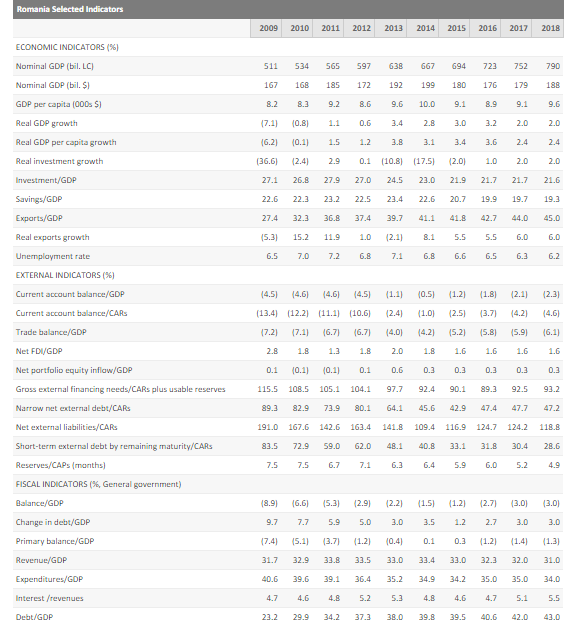De ce ratingul Romaniei nu este majorat, daca economia duduie? Standard&Poors explica: din cauza slabei administrari a bugetului public
 Autor: Bancherul.ro
Autor: Bancherul.ro
2015-10-13 10:03
“Poor governance framework”. Aceasta expresie, care catalogheaza cadrul de guvernare ca fiind slab, poarta principala vina pentru faptul ca ratingul Romaniei (BBB-) ramane in continuare neschimbat de catre agentia americana Standard&Poors.
Aceasta a reconfimat, in 9 octombrie, ratingul Romaniei, cu perspectiva stabila, cu urmatoarele explicatii: “Ratingul este sustinut de datoria externa si cea publica moderate, in contextul unei cresteri economice relativ robusta. Ratingurile sunt afectate de cadrul slab de guvernare, in ciuda recentelor eforturi de reducere a coruptiei, de nivelul inca redus al PIB-ului pe locuitor (9.000 de dolari) in comparatia cu tarile vecine, precum si nivelul inca ridicat, desi in scadere, a datoriei sectorului privat, majoritatea in valuta, ceea ce poate afecta transmiterea politicii monetare.
Adoptarea noului Cod fiscal, cu masurile prociclice de relaxare fiscala, precum reducerea TVA-ului, va anula o parte din consolidarea fiscala obtinuta de autoritatile romane incepand in 2009, insotita de o crestere de 4% a PIB-ului in perioada 2009-2014, considera agentia de rating.
Aceasta mentioneaza ca ar putea majora ratingul Romaniei daca va continua consolidarea bugetara si daca vor fi implementate cu succes restructurarile companiilor de stat, avand ca efect scaderea datoriei publice, la care sa se adauge si o reducere a vulnerabilitatii sectorului privat (banci) fata de fluctuatiile de curs valutar.
Pe de alta parte, mentioneaza Standard&Poors, ratingul ar putea fi scazut in urmatoarele situatii:
- daca schimbarile de politici guvernamentale ar putea duce la cresterea deficitelor si datoriei publice semnificativ peste nivelul asteptat;
- daca reapar dezechilibrele externe ale Romaniei;
- daca scade stabilitatea sistemului financiar.
Agentia de rating prognozeaza o crestere a datoriei publice la 43% din PIB in 2018, mai mult decat precedenta prognoza, de 41% din PIB.
Desi guvernul se va incadra in acest an in tinta de deficit bugetar, datorita incasarilor peste asteptari si a cheltuielilor reduse, acesta va ajunge la 3% in 2017.
Standard&Poors anticipeaza insa ca guvenul va adopta masuri populiste inaintea alegerilor de anul viitor si in contextul acuzatiilor de coruptie la adresa premierului Victor Ponta.
Comunicatul agentiei de rating Standard&Poors:
Romania 'BBB-/A-3' Ratings Affirmed; Outlook Stable (09-Oct-2015)
OVERVIEW
We expect the Romanian economy to grow by 2.6% on average from 2015-2018, with domestic demand contributing a greater role.
While the changes in the fiscal code are likely to widen the fiscal deficit, we do not expect general government indebtedness to be significantly affected.
We are therefore affirming our 'BBB-/A-3' ratings on Romania.
The stable outlook balances the likelihood of risks to fiscal consolidation against Romania's generally robust growth prospects.
RATING ACTION
On Oct. 9, 2015, Standard & Poor's Ratings Services affirmed its 'BBB-/A-3' long- and short-term foreign and local currency sovereign credit ratings on Romania.
The outlook is stable.
RATIONALE
The ratings are supported by Romania's moderate external and fiscal indebtedness amid relatively firm growth prospects.
The ratings are constrained by the poor governance framework, despite recent efforts to reduce corruption; low GDP per capita relative to peers (estimated at $9,000 in 2015); and still-high--though declining--private-sector debt, denominated in foreign currency, which can restrict the effective transmission of monetary policy.
A strong procyclical fiscal impulse--most visibly manifest in value-added tax (VAT) cuts in food products and hikes in minimum wages--has benefitted private consumption, as have falling oil prices, rising incomes, and employment.
Further cuts in indirect taxes, together with a host of other fiscal measures, are likely to support Romania's cyclical recovery in 2016 and 2017.
We therefore expect real GDP to grow by 3% in 2015 and at an average rate of 2.6% between 2015 and 2018.
We note that while the current fiscal stance has been supportive to consumption growth, we expect investment in 2015 will still be about a third below its precrisis high.
Risks to our growth forecast include a continued low rate of absorption of EU funds, low public investment, an uncertain external environment amplified by geopolitical risks, or lower-than-anticipated inflows of foreign direct investment (FDI).
A weaker-than-projected recovery of credit growth to the private sector by Romania's predominantly foreign-owned banks could constitute an additional risk, as could the possibility of wages outpacing productivity improvements, leading to a loss of external competitiveness.
Since 2009, Romanian policymakers have been consolidating government finances through the imposition of tough procyclical expenditure constraints, aided by
average nominal GDP growth of 4% over 2009-2014.
We view the changes to the fiscal code, in the form of amendments passed by parliament in June 2015, as
rolling back some of those gains.
Adopted measures include a phased cut in the standard VAT rate to 19% from the current 24% in 2017, tax exemptions, the reduction in the tax on dividends, changes in social contributions, and cuts in excise duties.
While we think the government is likely to outperform its fiscal target in 2015 following higher-than-anticipated revenue intake and constrained capital expenditure, we expect a widening of the general government fiscal deficit toward 3% in 2017.
While our expectation is based on a continued recovery in domestic demand aiding revenue collection, thereby
absorbing some revenue losses, we also anticipate further fiscal loosening in the run-up to the parliamentary elections in 2016.
The proposed hikes in public wages are an example of such a downside risk.
Indeed, the electoral calendar and ongoing events in Romania´s political sphere--such as the trial of Prime Minister Victor Ponta on corruption charges--could prompt a further spate of populist measures.
With our revised deficit forecast, we now project higher government indebtedness, with general government debt peaking at 43% of GDP in 2018, versus our earlier projection of a peak in the debt-to-GDP ratio at 41% in
2017.
Net debt will remain lower than general government debt, owing to government deposits and fiscal reserves, which we project will remain above 5% of GDP across our forecast horizon to 2018.
Just over 50% of gross general government debt is denominated in foreign currency, predominantly euros, indicating some vulnerability to adverse exchange-rate movements.
Romania's external finances have rebalanced substantially from pre-2009 levels--on both stock and flow metrics--led by banking sector deleveraging and an adjustment of the current account deficit toward balance.
We expect the current account deficit will widen slightly over 2015-2018, reflecting higher domestic demand.
However, an improvement in energy efficiency and gradually increasing value-add in some pockets of Romania's expanding export sector are likely to prevent external imbalances from re-emerging.
We anticipate that, from 2017, Romania's current account deficit will be overfunded by surpluses on the capital account and the financial account.
We think the latter will benefit from continuing FDI inflows, public- and private-sector borrowings, and slowing net outflows from the financial sector as domestic lending opportunities increase.
We expect deflation, prompted by the June cut in the VAT rate on foodstuffs, to persist until the middle of next year as further tax cuts are implemented in early 2016.
Although Romania enjoys a managed-float exchange rate regime, monetary policy remains constrained by the relatively high share of foreign currency loans contracted by the private sector.
That said, we expect euroization to continue to decline, helped by National Bank of Romania policies, such as prudential measures to discourage foreign currency lending
to households, narrowing the interest rate differential between loans denominated in Romanian leu and those denominated in foreign currency, and maintaining higher reserve requirements for liabilities in foreign currency
relative to liabilities denominated in leu.
Because the majority of foreign currency loans are denominated in euros, the Romanian private sector has been left relatively unscathed by the 13% depreciation of the Romanian leu against the dollar since October last year.
We also note that given the relatively low proportion of Swiss franc lending compared with some regional peers, such as Poland, there is less pressure on Romanian policymakers to adopt a centralized approach for unhedged Swiss franc borrowers who have been adversely affected by the franc's recent appreciation.
OUTLOOK
The stable outlook balances the likelihood of risks to fiscal consolidation against Romania's relatively robust growth prospects.
We could raise the ratings if Romania's budgetary consolidation continues and public enterprise restructuring is implemented successfully, leading to a reduction in net government debt, matched by a further decrease in
private-sector vulnerability to exchange rate fluctuations.
We could lower the ratings on Romania if any of the following scenarios materialize:
- We think policy reversals could cause general government deficits and indebtedness to increase significantly more than we currently expect,
- Romania's external imbalances re-emerge, or
- The stability of Romania's financial sector weakens.
Comentarii
Adauga un comentariu
Adauga un comentariu folosind contul de Facebook
Alte stiri din categoria: Opinie
Banca Transilvania implineste 30 de ani
Mesaj top management BT, 16 februarie 2024 Banca Transilvania: Sunt 30 de ani de când creștem în România și de când vedem România crescând Astăzi este ziua Băncii Transilvania. Orice aniversare ne duce cu detalii
De cand si cat de mult ar putea sa scada dobanzile in 2024?
Diminuarea inflatiei ridica intrebarea cu privire la momentul in care ar putea sa inceapa sa scada si dobanda de referinta stabilita de Banca Nationala a Romaniei (BNR) si implicit cele la credite si depozite. Discutiile privind scaderea dobanzii BNR ar putea detalii
Ce responsabilitate au bancile in cazul fraudelor online?
„Am fost victima unei fraude prin Neocapital și mi s-au furat sume importante prin transfer online neautorizat de mine”, ne-a scris un cititor. „Sint grupuri organizate, iar băncile nu au sisteme de securizare eficienta a conturilor detalii
Creditele ipotecare ar putea creste in 2024, estimeaza Banca Transilvania
Banca Transilvania se asteapa ca cererea de credite ipotecare sa creasca in 2024, datorita reducerii dobanzilor si a unei oferte de preturi mai accesibile pe piata rezidentiala, conform declaratiilor directorului bancii, Omer Tetik. ”Creșterea detalii
- Rambursarea ratelor la credite in Romania se face ca in celelalte tari din Europa; motoda propusa de ANPC este contrara interesului consumatorilor
- De ce ar majora bancile comisioanele pentru cash, daca se limiteaza cash-ul?
- Simona Halep, sustinuta in continuare de Banca Transilvania
- Romanii au incredere in banci ca le pot rezolva problemele, arata un sondaj
- Bancile sunt suspectate ca blocheaza accesul unor clienti la credite, prin scorul FICO al Biroului de Credit
- Doar 21% dintre romani au probleme cu băncile și IFN-urile, arata un sondaj CSALB
- De ce trebuie sa merg la ghiseu pentru activarea aplicatiei YOU BRD? (actualizat)
- Contractele cu bancile si IFN-urile pot fi imbunatatite cu ajutorul CSALB
- ARB acuza ANPC de abuz si prejudicii grave de imagine aduse sistemului bancar
- BCR explica diferenta dintre ratele egale si cele descrescatoare la credite
Profil de Bancher
-
Claudiu Cercel Duca, Director General adjunct
BRD

Din 2 octombrie 2008, Claudiu Cercel - Duca ... vezi profil
Criza COVID-19
- In majoritatea unitatilor BRD se poate intra fara certificat verde
- La BCR se poate intra fara certificat verde
- Firmele, obligate sa dea zile libere parintilor care stau cu copiii in timpul pandemiei de coronavirus
- CEC Bank: accesul in banca se face fara certificat verde
- Cum se amana ratele la creditele Garanti BBVA
Topuri Banci
- Topul bancilor dupa active si cota de piata in perioada 2022-2015
- Topul bancilor cu cele mai mici dobanzi la creditele de nevoi personale
- Topul bancilor la active in 2019
- Topul celor mai mari banci din Romania dupa valoarea activelor in 2018
- Topul bancilor dupa active in 2017
Asociatia Romana a Bancilor (ARB)
- Băncile din România nu au majorat comisioanele aferente operațiunilor în numerar
- Concurs de educatie financiara pentru elevi, cu premii in bani
- Creditele acordate de banci au crescut cu 14% in 2022
- Romanii stiu educatie financiara de nota 7
- Gradul de incluziune financiara in Romania a ajuns la aproape 70%
ROBOR
- ROBOR: ce este, cum se calculeaza, ce il influenteaza, explicat de Asociatia Pietelor Financiare
- ROBOR a scazut la 1,59%, dupa ce BNR a redus dobanda la 1,25%
- Dobanzile variabile la creditele noi in lei nu scad, pentru ca IRCC ramane aproape neschimbat, la 2,4%, desi ROBOR s-a micsorat cu un punct, la 2,2%
- IRCC, indicele de dobanda pentru creditele in lei ale persoanelor fizice, a scazut la 1,75%, dar nu va avea efecte imediate pe piata creditarii
- Istoricul ROBOR la 3 luni, in perioada 01.08.1995 - 31.12.2019
Taxa bancara
- Normele metodologice pentru aplicarea taxei bancare, publicate de Ministerul Finantelor
- Noul ROBOR se va aplica automat la creditele noi si prin refinantare la cele in derulare
- Taxa bancara ar putea fi redusa de la 1,2% la 0,4% la bancile mari si 0,2% la cele mici, insa bancherii avertizeaza ca indiferent de nivelul acesteia, intermedierea financiara va scadea iar dobanzile vor creste
- Raiffeisen anunta ca activitatea bancii a incetinit substantial din cauza taxei bancare; strategia va fi reevaluata, nu vor mai fi acordate credite cu dobanzi mici
- Tariceanu anunta un acord de principiu privind taxa bancara: ROBOR-ul ar putea fi inlocuit cu marja de dobanda a bancilor
Statistici BNR
- Deficitul contului curent după primele două luni, mai mare cu 25%
- Deficitul contului curent, -0,39% din PIB după prima lună a anului
- Deficitul contului curent, redus cu 17%
- Inflatia a încheiat anul 2023 la 6,61%, semnificativ sub prognoza oficială
- Deficitul contului curent, redus cu o cincime după primele zece luni ale anului
Legislatie
- Legea nr. 311/2015 privind schemele de garantare a depozitelor şi Fondul de garantare a depozitelor bancare
- Rambursarea anticipata a unui credit, conform OUG 50/2010
- OUG nr.21 din 1992 privind protectia consumatorului, actualizata
- Legea nr. 190 din 1999 privind creditul ipotecar pentru investiții imobiliare
- Reguli privind stabilirea ratelor de referinţă ROBID şi ROBOR
Lege plafonare dobanzi credite
- BNR propune Parlamentului plafonarea dobanzilor la creditele bancilor intre 1,5 si 4 ori peste DAE medie, in functie de tipul creditului; in cazul IFN-urilor, plafonarea dobanzilor nu se justifica
- Legile privind plafonarea dobanzilor la credite si a datoriilor preluate de firmele de recuperare se discuta in Parlament (actualizat)
- Legea privind plafonarea dobanzilor la credite nu a fost inclusa pe ordinea de zi a comisiilor din Camera Deputatilor
- Senatorul Zamfir, despre plafonarea dobanzilor la credite: numai bou-i consecvent!
- Parlamentul dezbate marti legile de plafonare a dobanzilor la credite si a datoriilor cesionate de banci firmelor de recuperare (actualizat)
Anunturi banci
- Bancile comunica automat cu ANAF situatia popririlor
- BRD bate recordul la credite de consum, in ciuda dobanzilor mari, si obtine un profit ridicat
- CEC Bank a preluat Fondul de Garantare a Creditului Rural
- BCR aproba credite online prin aplicatia George, dar contractele se semneaza la banca
- Aplicatia Eximbank, indisponibila temporar
Analize economice
- Rezultatul economic pe 2023, tot +2,1% dar cu 7 miliarde lei mai mare
- România - prima în UE la inflație, prin efect de bază
- Deficitul comercial lunar a revenit peste cota de 2 miliarde euro
- România, 78% din media UE la PIB/locuitor în 2023
- România - prima în UE la inflație, prin efect de bază
Ministerul Finantelor
- Deficitul bugetar, -2,06% din PIB pe primul trimestru al anului
- Datoria publică, imediat sub pragul de 50% din PIB la începutul anului 2024
- Deficitul bugetar, deja -1,67% din PIB după primele două luni
- Datoria publică, sub pragul de 50% din PIB la finele anului 2023
- Deficitul bugetar, din ce în ce mai mare la început de an
Biroul de Credit
- FUNDAMENTAREA LEGALITATII PRELUCRARII DATELOR PERSONALE IN SISTEMUL BIROULUI DE CREDIT
- BCR: prelucrarea datelor personale la Biroul de Credit
- Care banci si IFN-uri raporteaza clientii la Biroul de Credit
- Ce trebuie sa stim despre Biroul de Credit
- Care este procedura BCR de raportare a clientilor la Biroul de Credit
Procese
- Un client Credius obtine in justitie anularea creditului, din cauza dobanzii prea mari
- Hotararea judecatoriei prin care Aedificium, fosta Raiffeisen Banca pentru Locuinte, si statul sunt obligati sa achite unui client prima de stat
- Decizia Curtii de Apel Bucuresti in procesul dintre Raiffeisen Banca pentru Locuinte si Curtea de Conturi
- Vodafone, obligata de judecatori sa despagubeasca un abonat caruia a refuzat sa-i repare un telefon stricat sau sa-i dea banii inapoi (decizia instantei)
- Taxa de reziliere a abonamentului Vodafone inainte de termen este ilegala (decizia definitiva a judecatorilor)
Stiri economice
- România, total în afara țărilor similare cu deficitul de cont curent
- Producția industrială pe februarie, cu aproape 7% sub cea din urmă cu cinci ani
- Inflația anuală a revenit la nivelul de la finele anului anterior
- Pensia reală de asigurări sociale de stat a crescut anul trecut cu 2,9%
- Producția de cereale boabe pe 2023, cu o zecime mai mare față de anul precedent
Statistici
- Care este valoarea salariului minim brut si net pe economie in 2024?
- Cat va fi salariul brut si net in Romania in 2024, 2025, 2026 si 2027, conform prognozei oficiale
- România, pe ultimul loc în UE la evoluția productivității muncii în agricultură
- INS: Veniturile romanilor au crescut anul trecut cu 10%. Banii de mancare, redistribuiti cu precadere spre locuinta, transport si haine
- Inflatia anuala - 13,76% in aprilie 2022 si va ramane cu doua cifre pana la mijlocul anului viitor
FNGCIMM
- Programul IMM Invest continua si in 2021
- Garantiile de stat pentru credite acordate de FNGCIMM au crescut cu 185% in 2020
- Programul IMM invest se prelungeste pana in 30 iunie 2021
- Firmele pot obtine credite bancare garantate si subventionate de stat, pe baza facturilor (factoring), prin programul IMM Factor
- Programul IMM Leasing va fi operational in perioada urmatoare, anunta FNGCIMM
Calculator de credite
- ROBOR la 3 luni a scazut cu aproape un punct, dupa masurile luate de BNR; cu cat se reduce rata la credite?
- In ce mall din sectorul 4 pot face o simulare pentru o refinantare?
Noutati BCE
- Acord intre BCE si BNR pentru supravegherea bancilor
- Banca Centrala Europeana (BCE) explica de ce a majorat dobanda la 2%
- BCE creste dobanda la 2%, dupa ce inflatia a ajuns la 10%
- Dobânda pe termen lung a continuat să scadă in septembrie 2022. Ecartul față de Polonia și Cehia, redus semnificativ
- Rata dobanzii pe termen lung pentru Romania, in crestere la 2,96%
Noutati EBA
- Bancile romanesti detin cele mai multe titluri de stat din Europa
- Guidelines on legislative and non-legislative moratoria on loan repayments applied in the light of the COVID-19 crisis
- The EBA reactivates its Guidelines on legislative and non-legislative moratoria
- EBA publishes 2018 EU-wide stress test results
- EBA launches 2018 EU-wide transparency exercise
Noutati FGDB
- Banii din banci sunt garantati, anunta FGDB
- Depozitele bancare garantate de FGDB au crescut cu 13 miliarde lei
- Depozitele bancare garantate de FGDB reprezinta doua treimi din totalul depozitelor din bancile romanesti
- Peste 80% din depozitele bancare sunt garantate
- Depozitele bancare nu intra in campania electorala
CSALB
- La CSALB poti castiga un litigiu cu banca pe care l-ai pierde in instanta
- Negocierile dintre banci si clienti la CSALB, in crestere cu 30%
- Sondaj: dobanda fixa la credite, considerata mai buna decat cea variabila, desi este mai mare
- CSALB: Romanii cu credite caută soluții pentru reducerea ratelor. Cum raspund bancile
- O firma care a facut un schimb valutar gresit s-a inteles cu banca, prin intermediul CSALB
First Bank
- Ce trebuie sa faca cei care au asigurare la credit emisa de Euroins
- First Bank este reprezentanta Eurobank in Romania: ce se intampla cu creditele Bancpost?
- Clientii First Bank pot face plati prin Google Pay
- First Bank anunta rezultatele financiare din prima jumatate a anului 2021
- First Bank are o noua aplicatie de mobile banking
Noutati FMI
- FMI: criza COVID-19 se transforma in criza economica si financiara in 2020, suntem pregatiti cu 1 trilion (o mie de miliarde) de dolari, pentru a ajuta tarile in dificultate; prioritatea sunt ajutoarele financiare pentru familiile si firmele vulnerabile
- FMI cere BNR sa intareasca politica monetara iar Guvernului sa modifice legea pensiilor
- FMI: majorarea salariilor din sectorul public si legea pensiilor ar trebui reevaluate
- IMF statement of the 2018 Article IV Mission to Romania
- Jaewoo Lee, new IMF mission chief for Romania and Bulgaria
Noutati BERD
- Creditele neperformante (npl) - statistici BERD
- BERD este ingrijorata de investigatia autoritatilor din Republica Moldova la Victoria Bank, subsidiara Bancii Transilvania
- BERD dezvaluie cat a platit pe actiunile Piraeus Bank
- ING Bank si BERD finanteaza parcul logistic CTPark Bucharest
- EBRD hails Moldova banking breakthrough
Noutati Federal Reserve
- Federal Reserve anunta noi masuri extinse pentru combaterea crizei COVID-19, care produce pagube "imense" in Statele Unite si in lume
- Federal Reserve urca dobanda la 2,25%
- Federal Reserve decided to maintain the target range for the federal funds rate at 1-1/2 to 1-3/4 percent
- Federal Reserve majoreaza dobanda de referinta pentru dolar la 1,5% - 1,75%
- Federal Reserve issues FOMC statement
Noutati BEI
- BEI a redus cu 31% sprijinul acordat Romaniei in 2018
- Romania implements SME Initiative: EUR 580 m for Romanian businesses
- European Investment Bank (EIB) is lending EUR 20 million to Agricover Credit IFN
Mobile banking
- Comisioanele BRD pentru MyBRD Mobile, MyBRD Net, My BRD SMS
- Termeni si conditii contractuale ale serviciului You BRD
- Recomandari de securitate ale BRD pentru utilizatorii de internet/mobile banking
- CEC Bank - Ghid utilizare token sub forma de card bancar
- Cinci banci permit platile cu telefonul mobil prin Google Pay
Noutati Comisia Europeana
- Avertismentul Comitetului European pentru risc sistemic (CERS) privind vulnerabilitățile din sistemul financiar al Uniunii
- Cele mai mici preturi din Europa sunt in Romania
- State aid: Commission refers Romania to Court for failure to recover illegal aid worth up to €92 million
- Comisia Europeana publica raportul privind progresele inregistrate de Romania in cadrul mecanismului de cooperare si de verificare (MCV)
- Infringements: Commission refers Greece, Ireland and Romania to the Court of Justice for not implementing anti-money laundering rules
Noutati BVB
- BET AeRO, primul indice pentru piata AeRO, la BVB
- Laptaria cu Caimac s-a listat pe piata AeRO a BVB
- Banca Transilvania plateste un dividend brut pe actiune de 0,17 lei din profitul pe 2018
- Obligatiunile Bancii Transilvania se tranzactioneaza la Bursa de Valori Bucuresti
- Obligatiunile Good Pople SA (FRU21) au debutat pe piata AeRO
Institutul National de Statistica
- Comerțul cu amănuntul, în expansiune la început de an
- România, pe locul 2 în UE la creșterea comerțului cu amănuntul în ianuarie 2024
- Comerțul cu amănuntul, în creștere cu 1,9% pe anul 2023
- Comerțul cu amănuntul, în creștere pe final de an
- Comerțul cu amănuntul, stabilizat la +2% față de anul anterior
Informatii utile asigurari
- Data de la care FGA face plati pentru asigurarile RCA Euroins: 17 mai 2023
- Asigurarea împotriva dezastrelor, valabilă și in caz de faliment
- Asiguratii nu au nevoie de documente de confirmare a cutremurului
- Cum functioneaza o asigurare de viata Metropolitan pentru un credit la Banca Transilvania?
- Care sunt documente necesare pentru dosarul de dauna la Cardif?
ING Bank
- La ING se vor putea face plati instant din decembrie 2022
- Cum evitam tentativele de frauda online?
- Clientii ING Bank trebuie sa-si actualizeze aplicatia Home Bank pana in 20 martie
- Obligatiunile Rockcastle, cel mai mare proprietar de centre comerciale din Europa Centrala si de Est, intermediata de ING Bank
- ING Bank transforma departamentul de responsabilitate sociala intr-unul de sustenabilitate
Ultimele Comentarii
-
Înșelăciune
O să depun plângere când ajung în România sunt mare escroci nu știiu cum am putut crede așa ... detalii
-
Înșelăciune
La fel am pățit și eu și ce credeți după ce am plătit tot felul de taxe amenință ca are ... detalii
-
Refuz de plată la o benzinărie suma de 103 euro
Mi s-au retras de două ori suma de 48 euro și suma de 103 euro suma corectă este de 48 de euro ... detalii
-
nevoia de banci
De ce credeti ca acum nu mai avem nevoie de banci si firme de asigurari? Pentru ca acum avem ... detalii
-
Mda
ACUM nu e nevoie de asa ceva .. acum vreo 20 de ani era nevoie ... ACUM de fapt nu mai e asa multa ... detalii









